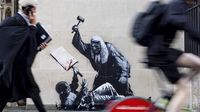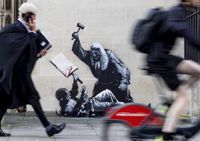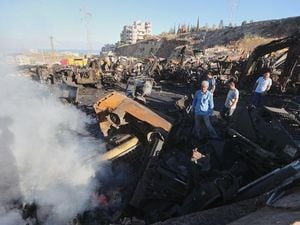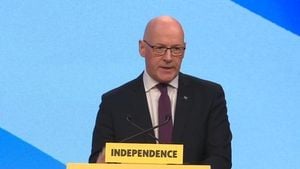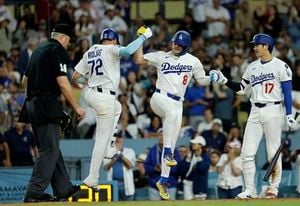Londoners awoke this week to a striking new mural by the elusive street artist Banksy, only to see it vanish as quickly as it appeared. On Monday, September 8, 2025, Banksy unveiled his latest work on the imposing façade of the Royal Courts of Justice in central London. The mural, rendered in stark black and white with a splash of red, depicted a bewigged judge in traditional robes raising a gavel against a protester sprawled on the ground. The protester’s placard, marked with a vivid red paint spatter resembling blood, left little doubt about the mural’s message. Within days, however, the artwork was scrubbed from the historic building, igniting fierce debate over free speech, protest rights, and the fate of public art in Britain.
Banksy, whose real identity remains one of the art world’s most closely guarded secrets, posted an image of the mural to his Instagram account with the understated caption: “Royal Courts Of Justice. London.” The piece was immediately interpreted as a searing commentary on the UK government’s recent crackdown on pro-Palestinian activism—specifically, the ban on the campaign group Palestine Action. According to TIME and Al Jazeera, the mural’s appearance followed a weekend of mass arrests, with nearly 900 protesters detained in London during demonstrations against the ban.
The government’s decision to designate Palestine Action a terrorist organization in July 2025 came after activists stormed a Royal Air Force base and damaged military aircraft. From that point, supporting or belonging to the group became a criminal offense, a move that rights groups and legal experts have sharply criticized as a threat to peaceful protest and free expression. Amnesty International called the ban “a disturbing legal overreach,” while campaigners accused Prime Minister Keir Starmer’s Labour government of criminalizing dissent and allowing military exports to Israel. Against this charged backdrop, Banksy’s mural was seen by many as a direct response to what activists described as “the brutality unleashed” by the new law, as reported by BBC and TIME.
Security officials wasted no time in responding to the mural’s appearance. By Monday evening, the artwork was obscured behind sheets of black plastic and metal barriers, watched over by two officers and a security camera. The following day, removal work began in earnest. Images captured by AP and AFP showed a masked worker scrubbing the mural from the wall, while police officers stood by. By Wednesday, September 10, the image was gone—erased from public view, but far from forgotten.
The Royal Courts of Justice, a 143-year-old Victorian Gothic landmark, is a listed building—one of Britain’s most protected heritage sites. In a statement, HM Courts & Tribunals Service explained, “The Royal Courts of Justice is a listed building and HMCTS are obliged to maintain its original character.” A spokesperson for the Ministry of Justice echoed this, telling The New York Times that the mural’s destruction was required under heritage laws. For some, this rationale rang hollow. The Good Law Project, a legal organization that filmed the mural’s removal, posted on social media: “The court is erasing Banksy’s mural just like it’s erasing our right to protest. Silencing a work of art about silencing protest? Maybe it was a little too close to home.”
Banksy’s choice of subject and location was anything but accidental. The Royal Courts stand as a symbol of British justice, yet the mural’s imagery—of a judge wielding a gavel as a weapon—spoke to mounting concerns about the use of law to suppress dissent. Defend Our Juries, the group that organized the recent protest, stated, “When the law is used as a tool to crush civil liberties, it does not extinguish dissent, it strengthens it.” The group asserted that the mural “powerfully depicts the brutality unleashed” by the government’s actions.
This is not the first time Banksy has used his art to highlight the Palestinian cause or to challenge government policy. Over the years, he has created numerous murals in the West Bank and Gaza, including images of a dove wearing a flak jacket and a masked protester hurling a bouquet of flowers. In 2017, he opened the “Walled Off Hotel” in Bethlehem, designed to offer “the worst view in the world”—a direct reference to the Israeli separation barrier. The hotel, which closed in October 2023, became a symbol of solidarity with Palestinians living under occupation.
Banksy’s work is often ephemeral, and the fate of his Royal Courts mural is hardly unique. According to TIME, many of his pieces have been destroyed, painted over, or stolen. In 2017, a three-story mural in Dover depicting a worker chipping away at a star on the European Union flag was whitewashed and later demolished along with the building. The artwork was valued at $1.2 million at the time. In December 2023, a Banksy piece featuring military drones on a Southeast London stop sign was stolen less than an hour after it was authenticated, with a market value of $500,000. Another painting, a wolf howling atop a satellite dish, was snatched by masked individuals just hours after its debut.
Even municipal authorities have inadvertently contributed to the loss of Banksy’s art. In 2009, Hackney Council workers mistakenly painted over a mural of the British Royal Family in East London, which had been featured on a Blur album cover. The building’s owner managed to stop them before the mural was completely erased. In another case, builders in Kent demolished a structure in 2023, unaware that they were destroying a valuable Banksy.
Banksy’s anonymity—originally adopted to avoid trouble with law enforcement—has only added to his mystique. Speculation over his identity continues to swirl, with names like Robin Gunningham and Robert Del Naja (of Massive Attack fame) frequently raised. But whoever Banksy may be, his art consistently commands global attention, commanding millions at auction and sparking debate wherever it appears.
The removal of the Royal Courts mural has only intensified the conversation about the boundaries of protest, the role of art in public life, and the responsibilities of institutions tasked with preserving history. As Britain grapples with questions of free speech and civil liberties, Banksy’s vanished mural lingers in the public imagination—a fleeting but powerful symbol of dissent, erased from stone but not from memory.
